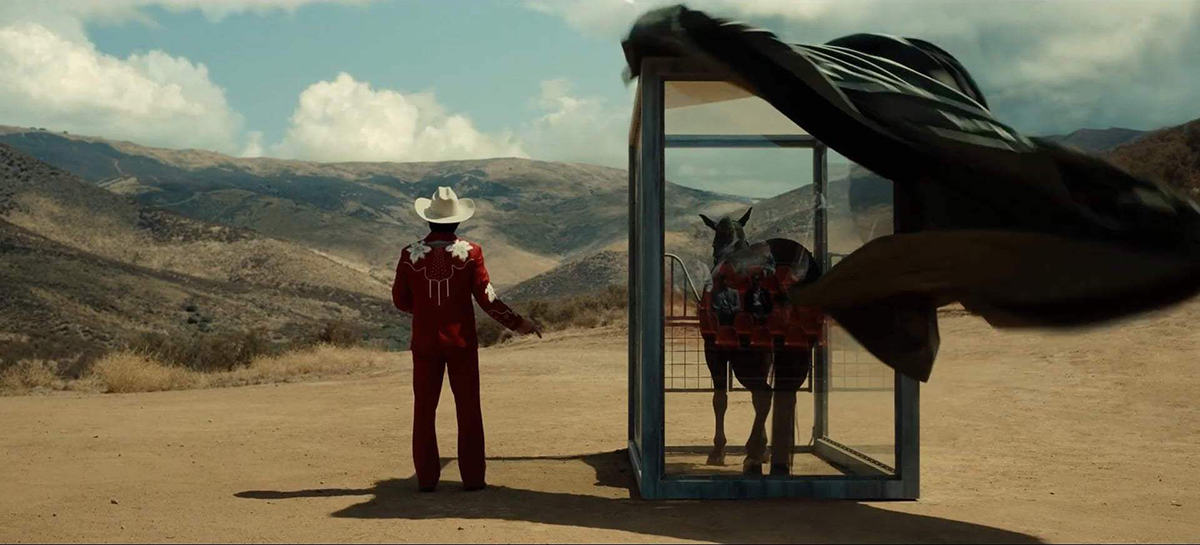Film review: Jordan Peele’s ‘Nope’ provides unsettling social commentary with strong execution

Steven Yeun stands beside a caged black horse, gazing into a mountain landscape. Starring alongside Yeun in Jordan Peele’s science-fiction horror film “Nope” are Daniel Kaluuya and Keke Palmer. (Courtesy of Universal Pictures)
“Nope”
Directed by Jordan Peele
Universal Pictures
July 22

By Ashley Kim
July 22, 2022 1:16 p.m.
This post was updated July 24 at 9:39 p.m.
Warning: spoilers ahead.
Jordan Peele takes a risk that audiences can say yes to in “Nope.”
In his third feature film, writer and director Peele once again successfully subverts his audience’s expectations of horror by blending it with science-fiction to create a spectacle filled with tension, subtext and thrill. Released Friday, “Nope” features previous collaborator Daniel Kaluuya as OJ Haywood and Keke Palmer as his sister, Emerald Haywood, as they seek to capture an alien presence in the sky. Peele’s masterful writing and direction are supported by captivating performances and artful audiovisual decisions, creating yet another riveting world through which to explore real-world issues.
[Related: Film review: ‘Men’ reveals monstrosity of misogyny with gory visuals but lacks cohesive plot]
With the threat of an unknown disk in the sky, the first act of the movie is steeped in suspense that leaves viewers guessing as to what exactly the nature of the antagonist is. In the startling introduction, the Haywoods’ father is struck by falling debris in a fatal accident and other mysterious occurrences such as power outages and sudden storms start up around their ranch. Peele further unsettles audiences with a tense sequence where it seems as if the alien creatures are playing with the ranch lights, but it ultimately turns out to be Ricky Park’s (Steven Yeun’s) kids playing a prank.
All of this buildup pays off when OJ determines that the flying disk is a hungry living creature and not something akin to a ship, as was predicted after a close encounter with the alien object. This reveal cleverly bridges together many of the seemingly disjointed images and sounds seen and heard since the beginning of the film – from the bright square amid a dark background to the faint echoes of screams that could be heard when the entity drew close – providing clarity to the audience. It is a testament to Peele’s writing that he is able to keep audiences hooked, despite them never knowing what the alien truly was, and propel the story forward even after the discovery.
The ingenious way in which OJ learns the alien’s true identity and, subsequently, how to vanquish it has to do with his experience as a handler for Hollywood horses and his connection to Alistair E. Haywood, who was the horse handler in the first moving picture ever created. In showing how OJ and Emerald are treated by a commercial crew as disposable, Peele deftly comments on the film industry and how it has pushed out Black people from the narrative despite their presence since the beginning.
This idea comes full circle at the end of the film when after all the action, Emerald sees OJ sitting upon his horse through the haze – a call back to the image of their ancestor riding his horse that was interspersed throughout the film. It is a cathartic moment filled with emotion that shows the human heart at the core of the film. Amid this uncanny alien presence and the resulting fear and chaos, OJ and Emerald establish a newfound connection and sibling love for each other.
All of these narrative choices are intricately written but sold by the performances, particularly Palmer’s larger-than-life presence and Kaluuya’s intense body language. Their chemistry as siblings is evident not only in the more comedic moments but also the dramatic, high-stakes sequences. The exquisite framing and immersive, rumbling score help further capture the energy and terror underlying the film.
Another layer of critique that is perhaps less evident but still effective is the film’s interest in the act of surveillance. Cameras are at the forefront of “Nope,” as the characters go to great lengths to capture the alien in hopes of fame and riches, but their elaborate plan is led astray when an outsider tries to film the alien themselves. When OJ eventually figures out that the alien will not consume people that do not look at it, it serves as a narrative choice that is familiar to the horror genre, yet Peele uses this to further develop his idea of watching to refreshingly comment on relevant themes.
[Related: Movie review: ‘Army of the Dead’ delivers engaging action, fails to subvert tired zombie tropes]
Through this plot device, Peele deftly touches on the greed of looking and the consequences of living in a society obsessed with spectacle. The alien represents a phenomenon that possesses people desperate for something bigger and more grotesque than their everyday lives to the point of danger. In this, Peele nimbly critiques society’s fixation on capturing real moments and urges the audience to consider the repercussions of their actions.
With incredible visuals and a compelling story, “Nope” is a definite sight to see.

